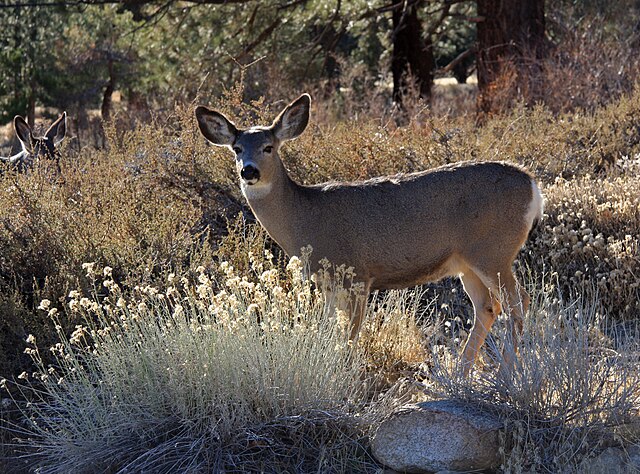The Rules of the Roadkill, Smart Phone-Version

Mule deer, pictured above, are common throughout the western United States. If you go to Wyoming — which, with about 500,000 people living there, is America’s least-populous state — you’re likely to see a few; there are about 400,000 mule deer in the state, or as the AP notes, “roughly two for every three of the state’s human residents.” In other words, they are widespread throughout the state and certainly are not at risk of extinction. And yet, their population numbers are still going in the wrong direction. Per that same AP report, “drought and diminishing habitat have played roles in reducing Wyoming mule [deer] numbers by almost 30% in the past 30 years.”
To help stem the decline in the deer population, Wyoming has cut back on mule deer hunting permits — much to the chagrin of many of its human population. Meat from the grocery store and butcher can be expensive; being able to hunt your own dinner can put food on the table at a more affordable price. In recent years, the Wyoming government has looked for ways to bridge this gap.
And in January of 2022, they found a solution: let people eat roadkill. All you need is the will to do it and, at least in Wyoming, a smartphone.
Roadkill, if you’re not familiar with the term, refers to animals that died while crossing the street, typically because they were run into by a car or truck. Nature has a way of cleaning up after itself; in time, other animals — scavengers — will come by and pick away at the corpse, and wind and other weather elements will further clear away some of the mess. But typically, that takes a lot of time, and no one wants to see a corpse rotting away on the side (or in the middle) of the road. The task of cleaning up roadkill typically falls to the local governments, and that’s not great. As Rawlins Times notes, in Wyoming, “crews from the Wyoming Department of Transportation wind up having to pick up the bloated carcasses along state highways. That’s not great for taxpayers, as the task eats into the department’s time, and it’s certainly not great for WYDOT crews, who have to pick up a stinking, decaying animal.”
For years, members of the Wyoming state legislature wanted to change this. The easiest way? Let people eat off the street, literally. In many states, it is perfectly legal to just pull a dead animal off the street and bring it home for dinner. But in areas where the local wildlife population is at risk, that’s not a good policy to have. Wyoming, being one of those places, didn’t let you legally take roadkill home before the summer of 2021, in order to avoid that specific problem.
What changed? Technology. Now, most of us have smartphones — very powerful computers that are connected to the Internet, sitting in our pocket (which, by the way, can also be used to place a telephone call). To collect roadkill in Wyoming, you need permission; the government wants to make sure that the animal you’re taking isn’t something that is threatened, endangered, or otherwise off-limits. But getting permission typically requires filling out forms and bringing them to a government office somewhere, and that takes time. When it comes to roadkill, time isn’t your friend — if you want to eat the meat, you want to be relatively certain that the carcass hasn’t been run over a bunch of times or picked at by scavenging animals.
But now? There’s now an app for that in Wyoming. The state Department of Transportation’s “Wyoming 511” app, which gives real-time traffic conditions on major roads, alerts drivers to potential road hazards, and gives drivers their location using GPS, expanded its offerings to allow people to ask for permission to collect roadkill in the moment. With a quick turnaround time, roadkill hunters can pick fresh meat off the road without having to worry too much about how long the animal had been sitting around.
There are still a lot of restrictions when it comes to what you can collect, when, and how. As Wyoming Public Media reports, only a few categories of animals — “wild bison, deer, elk, pronghorn, moose, and wild turkey” — can be taken off the road by roadkill hunters because the state wants to protect the populations of excluded animals. You can’t take dead animals off of major highways or after sundown, for safety reasons. And if you want part of the edible parts of the animals you have to take the rest of it as well; as part of the point is to clear the roads, you’re not allowed to leave any parts behind.
If you’re interested in trying out some Wyoming roadkill and need more details, great news: the state government created a “Roadkill Collection Information” website, here. It has links to the app, a three-minute tutorial video, and an FAQ. But as for finding your next meal, you’ll need a bit of luck — and some bad luck for the driver who came before you.
Bonus fact: While eating roadkill may sound gross, it may be more animal-friendly than other meat sources — at least, if you agree with what People for the Ethical Treatment of Animals (or PETA) has to say about it. Per PETA, “if people must eat animal carcasses, roadkill is a superior option” for a litany of reasons, including that the animal likely wasn’t terrified for too long before the fatal accident: “Perhaps the animals never knew what hit them.”
From the Archives: Street Meat: Meet Little Miss Roadkill.
